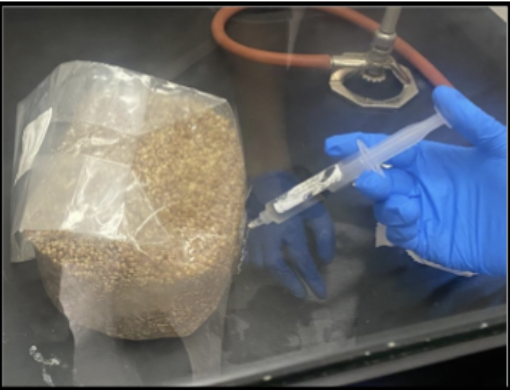Jackvoelker (talk | contribs) |
Jackvoelker (talk | contribs) |
||
| Line 2: | Line 2: | ||
Increases in the world’s population and subsequent urbanization has driven consumption levels of building materials higher. In order to meet this need, and maintain the sustainability of resources, novel, ecofriendly insulation materials must be developed. These types of insulation materials should possess excellent thermal, acoustic and electrical insulating properties. In this study, four bio-based mycelium-substrate composites were developed by creating combinations of two mushroom species (''T. versicolor'' and ''P. ostreatus'') and two different growth substrates derived from waste stream sources (paper and bagasse). To test these mycelium-substrate composites for thermal, acoustic and electrical insulating properties, three low-cost novel testing systems were developed. The test materials included paper, bagasse, ''T. versicolor''-paper composite (TP), ''T. versicolor''-bagasse composite (TB), ''P. ostreatus''-paper composite (PP), and ''P. ostreatus''-bagasse composite (PB). The ability of commercial insulation, TP, PP and PB to reduce heat flow across a temperature gradient over 40 minutes was found to be significantly better, as compared to no insulation, with thermal conductivity values of 0.0407, 0.0461, 0.0356, and 0.0336 W/(mK), respectively. These mycelium-substrate composites performed similarly to commercial insulation. The average percent reductions in sound were 0%, 22.97%, 7.97%, 11.08%, 25.24%, 16.08%, 28.76%, and 32.36% for no insulation, commercial insulation, paper, bagasse, TP, TB, PP and PB respectively. The average amperage for each test material was 0 amps in response to 50 V. These results warrant further investigation of these bio-based mycelium-substrate composites in order to determine their potential applications. | Increases in the world’s population and subsequent urbanization has driven consumption levels of building materials higher. In order to meet this need, and maintain the sustainability of resources, novel, ecofriendly insulation materials must be developed. These types of insulation materials should possess excellent thermal, acoustic and electrical insulating properties. In this study, four bio-based mycelium-substrate composites were developed by creating combinations of two mushroom species (''T. versicolor'' and ''P. ostreatus'') and two different growth substrates derived from waste stream sources (paper and bagasse). To test these mycelium-substrate composites for thermal, acoustic and electrical insulating properties, three low-cost novel testing systems were developed. The test materials included paper, bagasse, ''T. versicolor''-paper composite (TP), ''T. versicolor''-bagasse composite (TB), ''P. ostreatus''-paper composite (PP), and ''P. ostreatus''-bagasse composite (PB). The ability of commercial insulation, TP, PP and PB to reduce heat flow across a temperature gradient over 40 minutes was found to be significantly better, as compared to no insulation, with thermal conductivity values of 0.0407, 0.0461, 0.0356, and 0.0336 W/(mK), respectively. These mycelium-substrate composites performed similarly to commercial insulation. The average percent reductions in sound were 0%, 22.97%, 7.97%, 11.08%, 25.24%, 16.08%, 28.76%, and 32.36% for no insulation, commercial insulation, paper, bagasse, TP, TB, PP and PB respectively. The average amperage for each test material was 0 amps in response to 50 V. These results warrant further investigation of these bio-based mycelium-substrate composites in order to determine their potential applications. | ||
| + | |||
==1. Introduction== | ==1. Introduction== | ||
Revision as of 21:51, 1 August 2023
Abstract
Increases in the world’s population and subsequent urbanization has driven consumption levels of building materials higher. In order to meet this need, and maintain the sustainability of resources, novel, ecofriendly insulation materials must be developed. These types of insulation materials should possess excellent thermal, acoustic and electrical insulating properties. In this study, four bio-based mycelium-substrate composites were developed by creating combinations of two mushroom species (T. versicolor and P. ostreatus) and two different growth substrates derived from waste stream sources (paper and bagasse). To test these mycelium-substrate composites for thermal, acoustic and electrical insulating properties, three low-cost novel testing systems were developed. The test materials included paper, bagasse, T. versicolor-paper composite (TP), T. versicolor-bagasse composite (TB), P. ostreatus-paper composite (PP), and P. ostreatus-bagasse composite (PB). The ability of commercial insulation, TP, PP and PB to reduce heat flow across a temperature gradient over 40 minutes was found to be significantly better, as compared to no insulation, with thermal conductivity values of 0.0407, 0.0461, 0.0356, and 0.0336 W/(mK), respectively. These mycelium-substrate composites performed similarly to commercial insulation. The average percent reductions in sound were 0%, 22.97%, 7.97%, 11.08%, 25.24%, 16.08%, 28.76%, and 32.36% for no insulation, commercial insulation, paper, bagasse, TP, TB, PP and PB respectively. The average amperage for each test material was 0 amps in response to 50 V. These results warrant further investigation of these bio-based mycelium-substrate composites in order to determine their potential applications.
1. Introduction
1.1 Need
The incorporation of proper insulation when constructing a building allows for the maintenance of a desired temperature with minimal expenditure of energy, suppression of distracting noise from the external environment, and the prevention of combustion of electric cables within infrastructure. The world is experiencing an increasing population [1] and increasing demands for insulation. These trends expect to continue into the future. The global market for insulation is expected to increase from $67.74 billion/year in 2023 to $105.4 billion/year by 2050 [2].
The rising rates of urbanization and construction in developing countries, as well as higher energy prices are driving the increased demand for efficient cost-saving insulation. [3]. Commercially sold conventional insulation, such as fiberglass, is relatively expensive and hard to acquire for many developing countries. The synthetic materials used and the means of production of traditional insulation are harmful to the environment [4]. In addition, the materials used to create conventional insulation release toxic chemicals over time and are highly susceptible to molding and corrosion [5].
There is an urgent need to develop insulation materials that possess thermal, acoustic, and electrical insulating properties that can be easily manufactured in an environmentally responsible way. The creation of an effective and durable, yet environmentally friendly insulation composite utilizing recyclable materials is a promising option to achieve this goal. The demand for insulation due to high levels of construction activity in certain areas of the world [6] closely overlaps areas of significant paper [7] and bagasse production [8]. Due to their nature as waste stream products, if they could be effectively incorporated into an insulation material, the result would be a bioeconomic solution to this pressing problem.
Both materials are readily available, especially in developing countries, with an estimated 1.75 billion tons of bagasse being produced in 2019 [9], and an estimated 417 million metric tons of paper produced in 2021 [10]. Consequently, these waste materials can be locally sourced and used for the production of insulation in locations with the highest demand.
Here we propose the reclaiming of natural resources by utilizing waste streams from industrial activity and agriculture, to produce a needed product. In this paper we explore the effectiveness of thermal, acoustic, and electrical insulation of mycelium-based materials that use shredded paper and shredded bagasse, as substrates. Such an approach works towards achieving a circular bioeconomic solution to a pressing problem.
1.2 Thermal Insulation
As global energy usage increases, the incorporation of proper thermal insulation throughout the infrastructure of buildings is necessary to minimize heat gain/loss, and maintain a desired temperature [11]. A material with low thermal conductivity slows the rate of heat flow between the external environment and an enclosed space. Proper thermal insulation decreases the amount of energy that heating/cooling systems use to maintain comfortable temperatures. High quality insulation can reduce energy use in residential buildings by about 65% [12] and reduce carbon footprints associated with material use and disposal by more than 100 fold [13]. Therefore, effective thermal insulation is one of many ways to conserve energy [14].
Heat flow is the transfer of thermal energy from areas of high temperatures to lower temperatures. The thermal insulation properties of a material influence its ability to retard the rate of heat flow between regions of different temperatures [15]. The degree to which an insulator can reduce heat flow is dependent on its physical properties resulting from its composition. Synthetic or natural fibers are common materials used to manufacture insulation. Thermal insulation properties of materials depend on porosity [16] and tortuosity (ratio of the open pore length to the thickness) [12]. Heat transfer through fibrous materials is dependent on the number of fibers, packing geometry, and contact between fibers. Additionally, increasing the thickness of individual strands may reduce conduction heat transfer. Thicker webs capture more air, thereby decreasing conduction. The increase in thickness of strands leads to an increase in volume of air pockets within the insulation, thus trapping more thermal energy and slowing down the rate of conduction [17].
The ability of insulation to efficiently resist temperature change is dependent on its thermal conductivity [18]. Thermal conductivity can be determined using the Fitch Method. The Fitch Method includes a heat source, and heat sink. The heat source is a constant temperature heated vessel, which is at a high temperature. The heat sink is a copper block, that is at a lower temperature. The material of interest is placed between the heat source and heat sink. By utilizing this set up, the thermal conductivity of the material can be calculating, using the following equation, where k represents the thermal conductivity:
k= ( ln((Ti -T∞)/(Tf -T∞))*L *m *c)/(A * t) (Equation 1)
Ti and Tc represent the initial temperature and final temperature of the heat sink, in oC, respectively. L represents the thickness of the insulator, in meters. M represents the mass of the copper heat sink. c represents the specific heat of the copper heat sink. t represents the duration of the trial, in seconds. T∞ represents the average temperature of the heat source, in oC, and can be calculated using the following equation:
T∞= 1/((b-a)) ∫_a^b▒f(x)dx (Equation 2)
A and B represent the initial and final times at which the temperatures are recorded. F(x) is the function representing the change in temperature over time of the heat source. F(x) is found by generating a polynomial regression for the data points of temperature vs time [19].
1.3 Acoustic Insulation
Another challenge in the 21st century is reducing external noise pollution in order to maintain a living space that promotes concentration, productivity, and most importantly, quality rest. Large cities that are heavily populated produce excessive amounts of noise that not only inhibits work efficiency and quality of sleep, but long-term exposure may lead to detrimental health effects overtime such as damage to the cochlea membrane, increased progression of hearing loss, and long-term nerve damage within the ear canal [20]. The inclusion of an effective acoustic insulation in buildings would help to mitigate any health concerns by noise produced in urban centers, and maintain a comfortable and quiet living space.
Acoustics is the study of sound, its production, transmission, and effects. When sound waves come into contact with a material, they are either absorbed (converted to thermal energy), reflected (sent in the opposite direction), or transmitted (pass through the material). Upon contact with a given surface, sound waves with higher amplitudes are more likely to be transmitted whereas those with lower amplitudes are more likely to be reflected [21].
The behavior of sound waves is different based on the nature of the surface they come into contact with. The properties of soundproofing materials are heavily influenced by the density and porosity of the material being tested. Lower density materials experience easier absorption of the sound wave. However, if too low, the sound waves are able to pass through the material [22]. A material with high density tends to reflect sound waves off of its surface; however, if too high, minimal absorption will take place [23]. The porosity of the material determines its ability to suppress incoming soundwaves. The structure of porous materials allows sound waves to enter and dissipate [24]. When sound waves enter porous materials, the vibration of air molecules within the pores converts sound energy into thermal energy, increasing sound absorption [25]. The porosity and density characteristics of natural fibers and synthetic polymers make them excellent materials for the construction of acoustic insulation.
The sound absorbance efficiency of a material is represented by the sound absorption coefficient. The sound absorbance coefficient is the ratio of absorbed energy to incidence energy, and is represented by the following equation:
α = Ea/Ei= 1-Et/Ei (Equation 3)
α is the sound absorption coefficient. Ea , Ei and Et represent the absorbed, incidence, and total energy, respectively. The sound absorption coefficient has a value of 0 to 1, with 0 representing no energy absorbance, and 1 representing complete absorbance [26].
1.4 Electrical Insulation
One of the main concerns when designing a building is the orientation of electrical cables within the walls and the type of insulation that surrounds these electrical cables. When choosing an insulation that is in direct contact with these electrical cables, it is important to consider the electrical insulation properties of the material. Insulation that properly resists the flow of electricity protects the building from possible electrical fires. Electricity is a form of energy resulting from the flow of electrons through materials. Materials that are good conductors of electricity have many free moving/mobile electrons. Metals are generally great conductors of electricity. Dielectric materials such as natural fibers or synthetic polymers are poor conductors of electricity and good insulators due to their ability to impede the flow of electrons [27].
The electrical resistance of a material is its ability to impede the flow of electrons [28]. Ohm’s Law is an equation that relates the current, voltage and resistance of a system:
I = V/R (Equation 4)
1.5 Review of Previous Literature
Zach et al. (2016) created thermal and acoustic insulation materials by combining different amounts of recycled cotton, polyester, and flax fibers. The thermal conductivity and sound absorption properties of five different mixtures of the samples were tested by combining polyester, flax, cotton, and bicomponent polyester fiber. These materials had thermal conductivity values ranging from 0.0360 to 0.0443 W/(m*K) and sound absorption coefficients as high as 0.9-1 [29].
Manohar et al. (2002) examined the effectiveness of sugarcane fiber as building insulation. Sugarcane fiber was selected to be studied due to its abundance in developing countries, and the high frequency in which it is disposed of, rather than reused. The minimum thermal conductivity values of these sugarcane fiberboards were determined to be in the range of 0.0468 W/(m*K) to 0.0496 W/(m*K), values that are within the range generally seen for commercial building insulation [30].
Schritt et al. (2021) attempted to create mycelium-based insulation using various substrates. Fungal biotechnology is receiving increased attention in an effort to transition from a fossil-based economy to a bio-based economy. The two different mycelium species investigated were Ganoderma lucidum and Trametes versicolor. The substrates were sawdust, sawdust supplemented with nutrients, spent mushroom substrate, and spent mushroom substrate supplemented with nutrients. It was found that G. lucidum could recycle spent mushroom substrate, and T. versicolor could recycle sawdust substrate, with resulting thermal conductivity values of 0.06-0.07 W/(m*K) [31].
2. Methodology
2.1 Phase 1: Creation of Mycelium-Substrate Composites and Associated Analytics
2.1.1 Purchase of Trametes versicolor and Pleurotus ostreatus
The species of mycelium that were purchased for this experiment were Trametes versicolor, and Pleurotus ostreatus. Liquid Culture Syringes (10ml) were purchased from North Spore, Maine, United States. Both species produce non-toxic and edible mushrooms. Upon receipt, the syringes were refrigerated for 24 hours to ensure longevity [32].
2.1.2 Injection to Grain Spawn Bags
Grain spawn bags (1.4 kg) were purchased from North Spore. Approximately 3⅓ ml of the liquid culture syringes were injected into each grain spawn bag (as shown in Figure 1), resulting in 3 grain spawn bags for each species of mycelium.
Figure 1: Injection of Mycelium Liquid Cultures into Grain Spawn Bags
2.1.3 Substrate Preparation
The substrates used for this project were shredded paper bags and sugarcane bagasse. Shredded paper was created using a Cross-cut paper shredder (Staples, model SPL-1506X) to shred brown paper bags which were obtained from a local grocery store. Bagasse is the fibrous agro-waste from the production of sugar from sugarcane. All substrates were sterilized by an autoclave, at 15 psi and 121oC for 30 minutes. The substrates were torn up and shredded to roughly 1-cm long pieces to provide increased surface area for the mycelium to grow on.
2.1.4 Mycelium-Substrate Composite Production
Four different types of mycelium-substrate composites were created. These included T. versicolor -paper (TP), T. versicolor-bagasse (TB), P. ostreatus-paper (PP), and P. ostreatus-bagasse (PB). Cardboard boxes (20.32cm x 20.32 cm x 5.08cm) were used as molds for mycelium-substrate composite production. The interior of the cardboard boxes was covered with packaging tape to prevent mycelium growth through the boxes. For the mycelium-paper composites, approximately 133g of shredded paper were prepared as substrate for each panel. For the mycelium-bagasse composites, approximately 744g of water-saturated bagasse were prepared as substrate for each panel. Once the grain spawn bags had experienced sufficient mycelium growth, the mold and substrate materials were prepared for inoculation with mycelium. One grain spawn bag was mixed with enough substrate to create each of the 3 panels. Substrate and contents of the grain spawn bag were thoroughly mixed and the resulting mixture was split equally into each mold.
Once the molds were filled, they were covered with plastic wrap with air holes and stored in a cool, dark place out of direct sunlight (Figure 2a). The mycelium was expected to overtake the substrate and form solidified panels within 1-3 weeks depending on the species of mycelium.
Once the substrate had been completely infiltrated by the mycelium, the panels were removed from the molds (Figure 2b), weighed, and baked at 95oC until the composite reached a constant mass (Figure 2c).
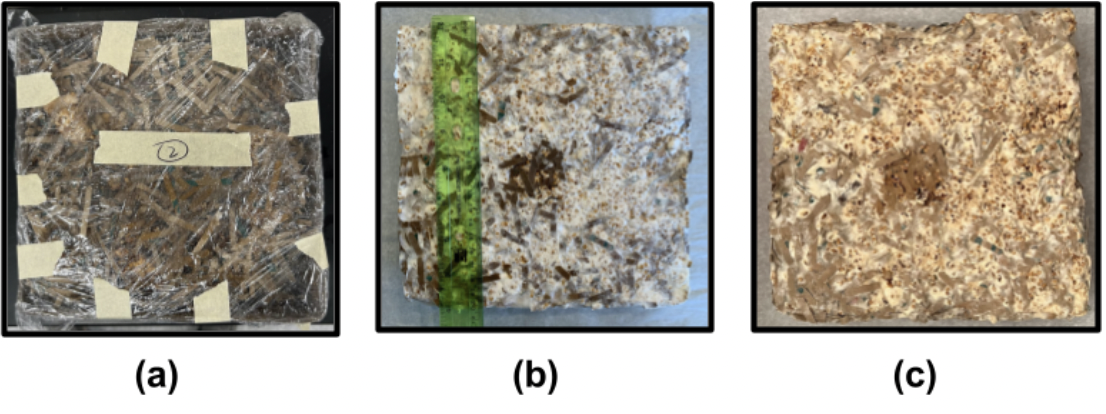 Figure 2: (a) Cardboard Mold filled with Mycelium-Paper Composite, (b) Mycelium- Paper Composite after Mycelium Growth and Infiltration of Substrate, and (c) Mycelium-Paper Composite After Baking.
Figure 2: (a) Cardboard Mold filled with Mycelium-Paper Composite, (b) Mycelium- Paper Composite after Mycelium Growth and Infiltration of Substrate, and (c) Mycelium-Paper Composite After Baking.
In addition to testing the mycelium-substrate composites, commercial insulation, paper by itself, and bagasse by itself were tested.
2.1.5 Determination of Density of Testing Materials
The density was calculated for all testing materials according to the following equation:
Density=mass/volume (Equation 6)
2.1.6 Scanning Electron Microscopy Imaging
Mycelium-substrate composite samples were sent to a lab, and SEM Imaging was conducted by a lab technician to create high quality images with high magnification that could be analyzed to calculate average distance between fibers. This would provide quantitative values.
2.1.7 Analysis of the SEM Images via ImageJ
On the ImageJ software, the average distance between fibers was calculated by importing the SEM Images. This was done by randomly selecting two adjacent fibers and utilizing the pixel:length ratio to calculate the distance between the fibers. This would allow for possible connections to be made between average distance between fibers and thermal/acoustic insulation performance.
2.2 Phase 2: Creation of Novel Systems
2.2.1 Thermal Novel System
In order to determine the thermal insulating properties of the various test materials, a low-cost thermal novel system was designed (Figure 3). The overall dimensions of the novel system were 74.1cm x 23cm x 23cm. A large, 5.08cm thick commercially available foam insulating board was purchased. Six pieces of the necessary dimensions were created from the foam insulating board. Industrial HVAC duct tape was used to join the pieces together. Two pieces of cardboard, 7.6cm apart in the center of the box, created a space to hold the test materials. Thus, the main portion of the testing system had 3 compartments, two compartments (approximately 28cm x 13cm x 18cm each; Chamber A and Chamber B). The cardboard panels were embedded approximately 6.4mm into the foam insulation on the three sides forming the main portion of the testing system to ensure that there were no gaps between the two chambers where temperature measurements would be made and the area holding the test materials. A lid was also created to serve as the cover for the testing system. Two grooves were scored in the lid of the box to form tracks for the cardboard dividers to slide into during testing. A Vernier Stainless Steel Temperature Probe (Order Code: TMP-BTA) was placed through the lid approximately 9.5 cm from the center, inside both chambers. At the start of each trial, the temperature in each of the chambers was the same. To test the insulating property of each of the test materials, 2 different conditions were used. In one set of trials, a beaker with 500mL of water at 95oC was placed in Chamber A, while Chamber B was at room temperature. In a second set of trials, a beaker containing 500g of dry ice pellets was placed in Chamber A, while Chamber B was at room temperature. In Chamber B, temperature measurements were collected every 30 seconds for 40 minutes using a Vernier LabQuest 3 (Order Code: LABQ3). Thus, the change in temperature of Chamber B over time could be determined, and a graph of temperature change over time in Chamber B could be generated for both the hot water trials, and dry ice pellets trials.
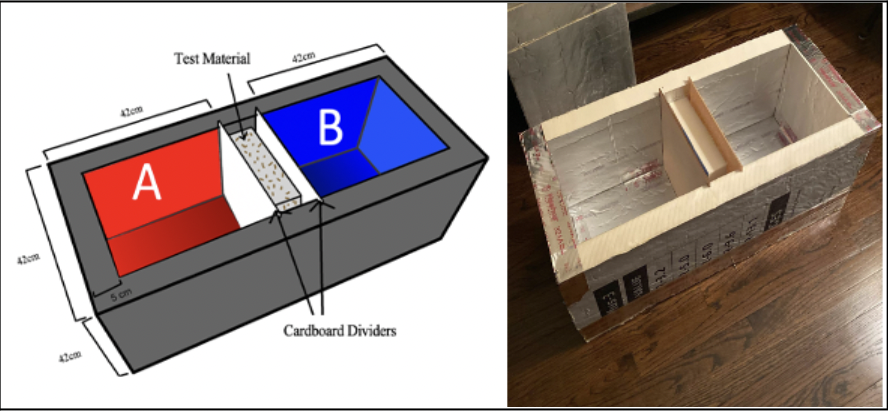 Figure 3: Low-Cost System for Testing Thermal Insulating Properties
Figure 3: Low-Cost System for Testing Thermal Insulating Properties
2.2.2 Acoustic Novel System
To reduce cost, an impedance tube was constructed out of standard PVC plastic pipes of different sizes (Figure 4). This novel system was used to measure the ability of the various test materials to reduce sound. One end of the tube contained a sound source (MIFA Bluetooth speaker) which was used to produce a consistent wave of broadband noise. A sample chamber was constructed out of 7.62cm diameter PVC Tube, a PVC Converter and flanges. The sample holder played a critical role of aligning the test piece in normal position to the direction of traveling planar waves. Connecting the tubes with standard flanges reduced the cost significantly. Standard PVC flanges are readily available in the market with minimum conditioning required to be used for the desired purpose. Flanges provide an easy way to secure the sample into place and make the assembly/disassembly simpler without adding more cost to the apparatus. Flanges were used for quick release and easy access to the sample in the test holder. Wing, nuts and bolts were used to tighten the flanges. With no material in the testing chamber, a 5 second long 200 Hz noise was played, and the amplitude of the generated sine curve was measured. Then, the same 5 second long 200 Hz noise was played with the various testing materials in the testing chamber, and the amplitude of the generated sine curve was measured. From here, the percent reduction in noise could be calculating for each material using the amplitude of the sine curve for the no material trials, and the amplitude of the sine curve for the various materials.
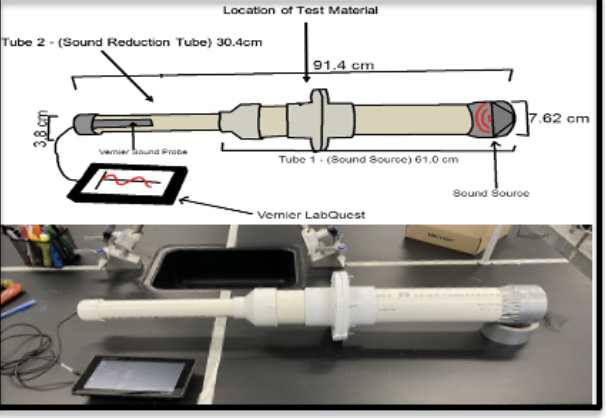 Figure 4: Low-Cost Impedance Tube
Figure 4: Low-Cost Impedance Tube
2.2.3 Electric Novel System
Figure 5 shows the schematic of the novel system for testing electrical current. An Elenco DC Power Supply (model XP-752A) was connected to an outlet in the wall, and used to generate a flow of electricity. Alligator clips came out of the power supply, and through holes cut out of a Styrofoam box. The test material was suspended between the alligator clips inside of the Styrofoam box. The power supply was used to generate a voltage of 50 volts, and measure the resulting current (in amps).
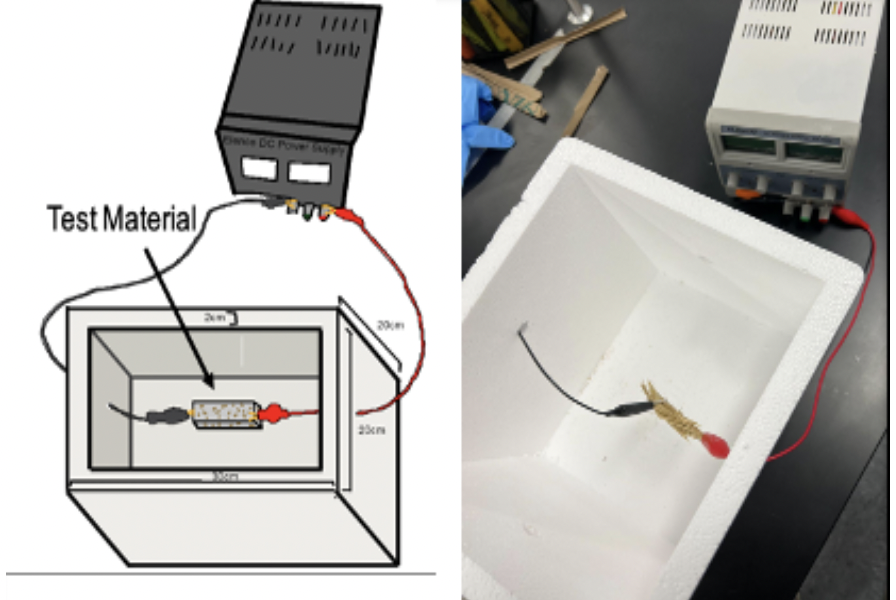 Figure 5: Schematic of Low-Cost Electric Current Testing System
Figure 5: Schematic of Low-Cost Electric Current Testing System
2.3 Phase 3: Measurement of Insulation Properties of Mycelium-Substrate Composites
Each of the novel systems above were used to collect data about the different insulating properties of the test materials. The thermal novel system measured the change in temperature over time (T) of Chamber B for both the hot and cold trials. The acoustic novel system was used to determine the percent noise reduction. The electric novel system was used to measure the amperage of the current, in response to 50 volts.
2.4 Data Analysis
For the thermal trials, statistical analysis was run at 10-minute intervals along the change in temperature graph in order to determine at which points the various test materials were significant compared to no insulation. This included using an IBM SPSS v.26 One Way ANOVA with Post-Hoc Scheffe (p<0.05) at each data point. A One Way ANOVA with Post-Hoc Scheffe was also used to compare the thermal conductivity values of the test materials. An IBM SPSS v.26 One-Way ANOVA was also used to compare the various percent noise reductions of the testing materials. However, statistical analysis was not run for the electrical trials, since there is no control for the data to be compared to (there must always be a material being attached to the alligator clips).
3. Results
3.1 Phase 1 Results
Three T. versicolor -paper (TP) composites were successfully created. Three T. versicolor-bagasse (TB) composites were successfully created. Three P. ostreatus-paper (PP) composites were successfully created. Three and P. ostreatus-bagasse (PB) composites were successfully created. The average densities of these materials were 0.30, 0.68, 0.51, 0.95 g/cm3, respectively. The average distance between fibers for PP and PB were 9.35um and 10.78um, respectively.
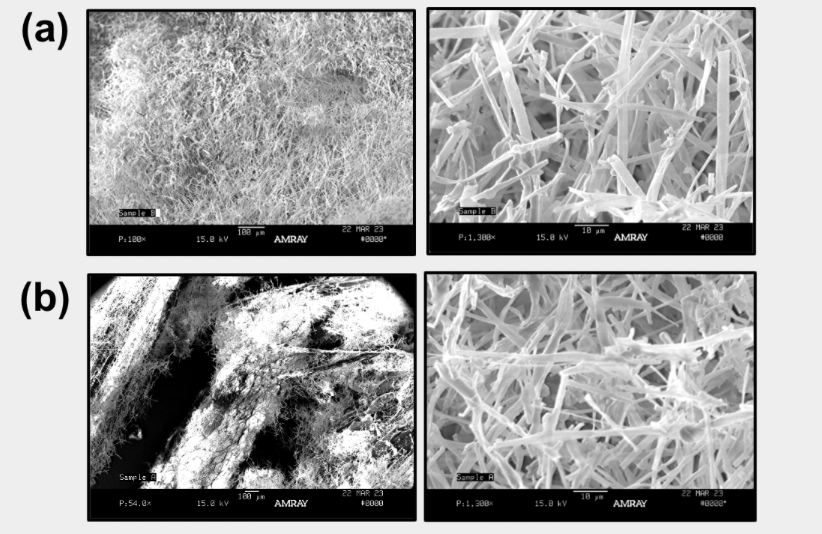 Figure 6: SEM Images of (a) PP and (b) PB Composites
Figure 6: SEM Images of (a) PP and (b) PB Composites
| Material | Commercial Insulation | Paper | Bagasse | T. versicolor-Paper | T. versicolor-Bagasse | P. ostreatus-Paper | P.ostreatus-Bagasse |
|---|---|---|---|---|---|---|---|
| Density (kg/m^3) | 0.116 | 0.229 | 0.302 | 0.299 | 0.678 | 0.507 | 0.949 |
Table 1: Densities of the Test Materials
3.2 Phase 2 Results
The three novel systems were successfully created based on the methodology previously mentioned.
3.3 Phase 3 Results
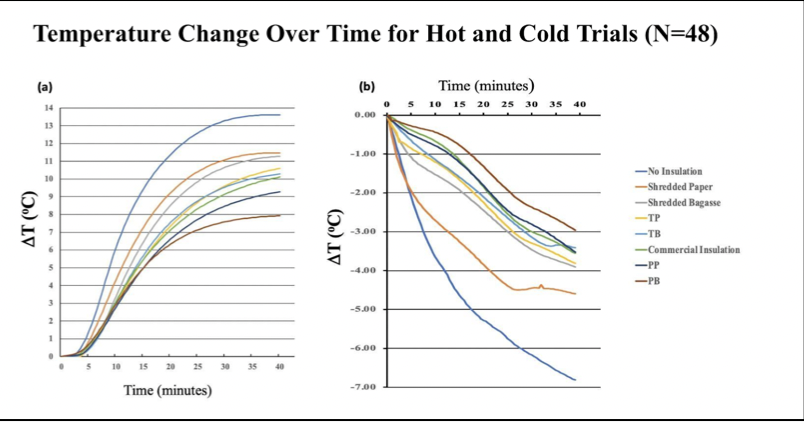 Figure 7: Change in Temperature Over Time for Various Test Materials for (a) Hot Trials and (b) Cold Trials
Figure 7: Change in Temperature Over Time for Various Test Materials for (a) Hot Trials and (b) Cold Trials
Figure 7 displays the change in temperature over time of Chamber B for both the hot and cold trials. Statistical analysis was conducted every 10 minutes, using IBM SPSS v.26 One-Way ANOVA with Post-Hoc Scheffe (p<0.05) in order to determine if the performance of the various test materials was significantly better than that of no insulation. For the hot trials, commercial insulation TP, PP and PB all retained significance at 10, 20, 30 and 40 minutes. This meant that a statistical analysis test was conducted for the different groups, based on their means, for the data at 10 minutes, 20 minutes, 30 minutes and 40 minutes. This meant 4 statistical tests were conducted for the hot trials. All groups experienced an increase in temperature, with PB having the lowest increase in temperature, indicating the highest success. For the cold trials, commercial insulation, shredded bagasse, TP, TB, PP and PB all retained significance at 10, 20, 30 and 40 minutes. This meant that a statistical analysis test was conducted for the different groups, based on their means, for the data at 10 minutes, 20 minutes, 30 minutes and 40 minutes. This meant 4 statistical tests were conducted for the cold trials. All groups experience a decrease in temperature, with PB having the smallest decrease, indicating the highest success.
| Material | Commercial Insulation | Paper | Bagasse | T. versicolor-Paper | T. versicolor-Bagasse | P. ostreatus-Paper | P.ostreatus-Bagasse |
|---|---|---|---|---|---|---|---|
| Thermal Conductivity (W/(m*K)) | 0.0407 | 0.0558 | 0.0539 | 0.0461 | 0.0444 | 0.0356 | 0.0336 |
Table 2: Thermal Conductivity Values of the Test Materials
The above table includes the densities and thermal conductivity values of the test materials.
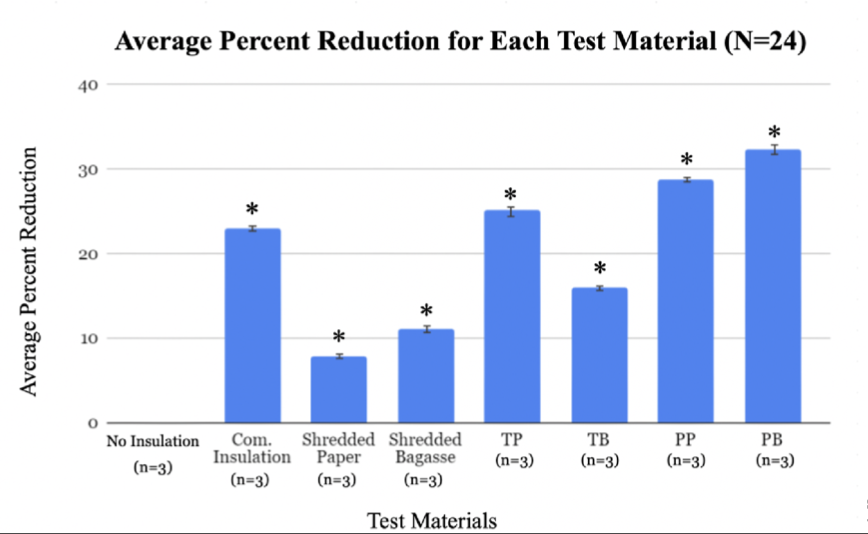 Figure 8: Percent Noise Reduction for Each Test Material
Figure 8: Percent Noise Reduction for Each Test Material
The average percent reductions were 0±0%, 22.97±0.1559%, 7.97±0.1226%, 11.08±0.2467%, 25.24±0.4503%, 16.08±0.1021%, 28.76±0.122649%, and 32.36±0.4513% respectively. The standard deviations were 0, 0.1559, 0.1226, 0.2467, 0.4503, 0.1021, 0.122649, and 0.4513 respectively. The various test materials were compared to no insulation using IBM SPSS v. 26 One-Way ANOVA with Post-Hoc Scheffe (p<0.05). As indicated by the asterisks on the graph, all groups performed significantly better than no insulation.
4. Discussion
4.1 Thermal Insulating Properties
The purpose of this research was to evaluate the viability of mycelium-substrate composites as potential insulation materials for building applications. The study focused on three critical aspects: thermal, acoustic, and electrical properties. Our results demonstrated that these composites performed admirably across all three systems, suggesting that they indeed possess desirable properties for insulation. The data led to the acceptance of our alternate hypothesis in that the mycelium-substrate composites would have increased thermal and acoustic insulation properties compared to the substrates by themselves, and an amperage of 0A for all test materials.
As displayed in Figure 7, and supported by statistical analysis using IBM SPSS v27 One-Way ANOVA with Post Hoc Scheffe (p<0.05), commercial insulation, TP, PP and PB were effective thermal insulators throughout both the hot and cold trials. These mycelium-substrate composites performed similarly to the commercial foam board. The success of both the PP and PB composites is likely the result of the vigorous rate of growth of P. ostreatus. As a result of its fast-growing nature, thicker fibers formed, with greater amounts of entrapped air between the fibers. This meant a lower conduction of heat transfer. Additionally, this results in a tortuous path of heat flow, resulting in fiber-to-fiber conduction (heat flow via fibers), and overall lower heat transfer. The PB composite had a similar microstructure as fiberglass, a standard thermal insulation that is currently sold commercially (Figure 11). The lower, but still somewhat successful results of the TP and TB composites is the result of their less vigorous infiltration of the mycelium into the substrate, and therefore less fibrous nature. The low success of the substrates by themselves in the thermal novel system is likely the result of their less dense nature, resulting in large holes between the structures. This study is supported by Manohar et al. (2002), who produced effective thermal insulation materials with a combination of sugarcane fiber and cornstarch, with thermal conductivity values similar to ours in the range of 0.0318 to 0.0508 W/(m*K) [30].
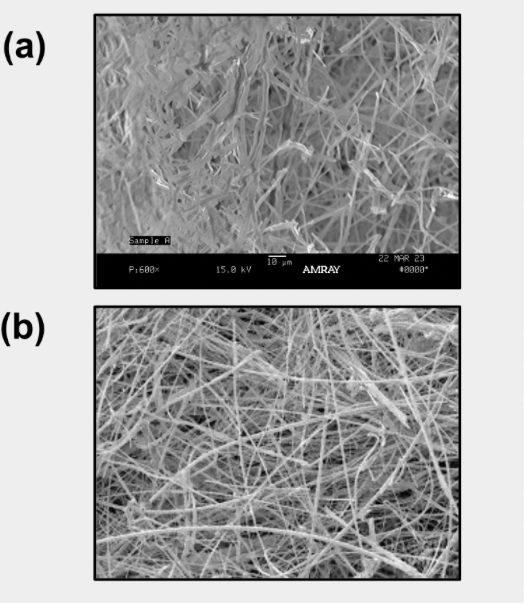 Figure 9: Similar Structure of (a) PB Composite (image by lab technician)and (b) Fiberglass [33]
Figure 9: Similar Structure of (a) PB Composite (image by lab technician)and (b) Fiberglass [33]
4.2 Acoustic Insulating Properties
As seen in Figure 9, all groups proved to be effective acoustic insulators, as they were able to reduce a substantial amount of noise. Statistical analysis using IBM SPSS v26 One-Way ANOVA with Post Hoc Scheffe (p<0.05) revealed significance for all groups compared to the no insulation.
Generally, the composites with higher densities were able to suppress a greater magnitude of noise. The PB composite had the highest density (0.95 g/cm3) and greatest percent noise reduction while the paper substrate by itself had one of the lowest densities and the lowest percent noise reduction. Higher density materials have a higher degree of suppression when compared to lower density materials [34]. Although lower densities have the ability to absorb sound waves, if the density is too low, sound waves may be able to pass through the material, leading to a lower degree of suppression [35]. Thicker and higher density materials had the best success in suppressing noise, since it is more difficult for sound waves to permeate through the material, leading to a higher degree of reflection [23]. The PP composite had a similar microstructure as expanded polystyrene, a standard acoustic insulation that is currently sold commercially (Figure 12).
Mycelium by itself is naturally fluffy and fibrous with pockets of air. Air pockets within the substrate can help absorb sound if infiltrated by another material, in this case mycelium. When sound waves enter an air pocket filled with mycelium, they are absorbed by the dense fibers or particles within the pocket.
 Figure 12: Similar Structure of (a) PP Composite (Image by Lab Technician, 2023) and (b) Expanded Polystyrene [36]
Figure 12: Similar Structure of (a) PP Composite (Image by Lab Technician, 2023) and (b) Expanded Polystyrene [36]
4.3 Electrical Insulation Properties
As seen in Figure Table 3, the average amperage for all groups was 0A, as expected. The degree to which a material can conduct electricity is dependent on mobile electrons. Metals are often great conductors of electricity due to their freely moving mobile electrons. Dielectric materials such as natural fibers or paper-based materials are poor conductors of electricity and good insulators due to their ability to resist the flow of electrons [27]. Since the mycelium and the substrates used are all considered dielectric materials, all samples were able to successfully resist the flow of electrons, making them great electrical insulators.
5. Conclusion
The field of mycelium-based materials has not been fully explored, and this study suggests a high potential for the repurposing of waste materials into suitable substrates for mycelium-substrate composites. The results supported the alternate hypothesis, as both the Trametes versicolor and Pleurotus ostreatus mycelium-substrate composites outperformed the substrates by themselves. All constructed mycelium-substrate composites exhibited commendable performance in thermal, acoustic, and electrical systems, signifying that they possess desirable properties for implementation in innovative insulation applications. The comparable performance of mycelium-substrate composites to commercial insulation in this study underscores the necessity for further investigation into these materials as viable alternatives in the insulation industry.
6. Future Studies
In light of the results from this study, the potential for further enhancement of the mycelium-substrate composites as insulative materials is vast and warrants additional exploration. Material optimization, such as refining the mycelium-substrate ratio and experimenting with a variety of substrate materials, could potentially improve the insulative properties of the composite. Detailed fire resistance rating experiments could also be performed. Selecting and cultivating different mycelium strains under varying growth conditions—temperature, humidity, and growth time—may yield a strain with superior insulation properties. Structurally, exploring designs like layered composites or cellular structures could enhance thermal and acoustic insulation characteristics. Lastly, post-treatment processes, such as curing, drying, or compression, might enhance the material's durability, strength, and insulation capacity. All of these enhancements would necessitate rigorous testing and optimization, utilizing professional equipment and adhering to industry standards. Utilizing a heat flow meter would allow for the determination of the thermal conductivity value of the mycelium-substrate composites. Additionally, rather than testing the percent noise reduction of these materials, an impedance tube could be used to determine the sound absorption coefficient. The ultimate aim remains the creation of a composite material that meets the rising demand for insulation, achieving a balance of high performance, sustainability, cost-effectiveness, and safety. With these prospective improvements, the future of mycelium-substrate composites in the insulation industry appears promising.
7. Bibliography
Al-Homoud, M. S. (2005). Performance characteristics and practical applications of common building thermal insulation materials. Building and Environment, 40, 353-366.
https://doi.org/10.1016/j.buildenv.2004.05.013
Aldawi, F., & Alam, F. (20165). Residential building wall systems: Energy efficiency and carbon footprint. In M. M. K. Khan & N. M. S. Hassan (Eds.), Thermofluid modeling for energy efficiency applications (169-196). Amsterdam, Netherlands: Academic Press.
https://doi.org/10.1016/C2014-0-01239-7
Anh, Le Duong Hung, Patsztory Zoltan (2021) An Overview of Factors Influencing Thermal Conductivity of Building Insulation Materials, Journal of Building Engineering, 43.16 116.
Armacell (2018), How to calculate “R” values, September 20, 2022 https://www.armacell.us/fileadmin/user_upload/Technical_Bulletins__Insulation/TB01_CalculateR-Value.US.EN.2018.pdf
Arora, R., & Mosch, W. (2022). High voltage and electrical insulation engineering. Hoboken, NJ: John Wiley & Sons, Inc.
Berardi, U., Iannace, G., 2015. Acoustic characterization of natural fibers for sound absorption applications. Build. Environ. 94, 840–852.
Cao, L., Qiuxia, F., Si, Y., Ding, B. & Yu, J. (2018). Porous materials for sound absorption.
Composites Communications, 10, 25-35. https://www.sciencedirect.com/science/article/abs/pii/S2452213918300433#:~:text=As% 20the%20most%20abundantly%20used,the%20field%20of%20sound%20absorption.
Connor, Nick, What is Fouier’s Law of Thermal Conduction?, May 21, 2022 https://www.thermal-engineering.org/what-is-fouriers-law-of-thermal-conductiondefinition/
Cunningham, N. (2016, November 21). Global demand for insulation. Insulation Outlook Magazine. https://insulation.org/io/articles/global-demand-for-insulation/
Denisova, L., Klyuchnikova, N., and Emelyanov, S., Soundproofing materials in construction using polymer composites, Materials: Science and Engineering, 945., 012010, 1-6 https://iopscience.iop.org/article/10.1088/1757-899X/945/1/012010/pdf
European Environment Agency. (2021, January 28). Plastic in textiles: Towards a circular economy for synthetic textiles in Europe. Resource efficiency and waste. Retrieved from https://www.eea.europa.eu/publications/plastic-in-textiles-towards-a/at_download/file
Flores, M., Nelson, Darío, F., & Hernández, O (2016) Influence of fibers partially coated with rubber from tire recycling as aggregate on the acoustical properties of rubberized concrete. Construction and Building Materials 129.,25–36.
<www.sciencedirect.com/science/article/abs/pii/S0950061816317494>.
Grid Arendal (2009) Paper and paperboard production, February 19, 2023 grida.no/resources/5856
Hadded, A., Benltoufa, S., Fayala, F., Jemni, A., 2016. Thermo physical characterisation of recycled textile materials used for building insulating. J. Build. Eng. 5, 34–40.
Hush City Soundproofing (2021), Hush, November 27, 2021 https://hush.info/
Insulation Institute. (2022). Residential insulation: Why is it important? Retrieved from https://insulationinstitute.org/im-a-building-or-facility-professional/residential/whyinsulate/?cn-reloaded=1
Knauf Insulation (2022), The Science of Insulation Explained, January 11, 2023 https://www.knaufinsulation.com.au/science-of-insulation-explained
Manohar, Krishpersad, Jaishree Ramropsingh, and David W. Yarbrough (2002) Use of Sugarcane Fiber as Building Insulation, ASTM Special Technical Publication, 299-313
North Spore (2022), North Spore, September 2, 2022 https://northspore.com
Pelanne, C. M. (1977). Heat flow principles in thermal insulations. Journal of Thermal
Insulation, 1(1), 48–80. https://doi.org/10.1177/109719637700100104
Peng, L (2017) Advanced High Strength Natural Fibre Composites in Construction, Elsevier Science, Netherlands, 1-20
Population Reference Bureau (2008), Global Aging and the Demographic Divide, October 15, 2022 https://www.prb.org/resources/global-aging-and-the-demographic-divide/.
Precedence Research (2022), Insulation Market (By Product: Expanded polystyrene, Glass wool, Mineral wool, Cellulose, Calcium silicate, Others; By Function: Thermal, Acoustic, Electric, Others; By Form: Blanket, Foam, Board, Pipe, Others; By End User) - Global
Industry Analysis, Size, Share, Growth, Trends, Regional Outlook, and Forecast 2022-
2030, October 22, 2022 https://www.precedenceresearch.com/insulation-market
RICS (2021), Global Construction Market Appears Firmly on Recovery Footing, November 18, 2022 https://www.rics.org/es/news-insight/latest-news/news-opinion/global-constructionmarket-appears-firmly-on-recovery-footing/.
Rienstra, A and S.W. Hirschberg (2021) An introduction to acoustics, Eindhoven University of Technology, Eindhoven, Netherlands, 41-52
Schmidt, A.C., Jensen, A.A., Clausen, A.U., Kamstrup, O., Postlethwaite, D., 2004. A comparative life cycle assessment of building insulation products made of stone wool, paper wool and flax. Int. J. Life Cycle Assess. 9, 53–66.
Schritt, Helge and Stephan Vidi, Daniel Pleissner (2021) Spent mushroom substrate and sawdust to produce mycelium-based thermal insulation composites, Journal of Cleaner Production, Vol 313., 127910, 0959-6526,
Smith, D.S., Alzina, A., Bourret, J., Nait-Ali, B., Pennec, F., Tessier-Doyen, N., et al., 2013. Thermal conductivity of porous materials. J. Mater. Res. 28, 2260–2272.
Singh, N., & Davar, S. C. (2004) Noise pollution-sources, effects and control. Journal of Human Ecology, 16(3), 181–187. https://doi.org/10.1080/09709274.2004.11905735
Starodubtseva, T., Aksomitny, A., Saldaev, V (2018). The Study of Soundproofing Properties of
Wood Polymer-Sand Composite. Solid State Phenomena, 284 993–998 https://www.scientific.net/SSP.284.993
Statista (2022), Production volume of paper and paperboard worldwide from 2010 to 2021, by type, December 27, 2022 https://www.statista.com/statistics/270317/production-volumeof-paper-by-type/.
Thani, S. K. S. O, Mohamad, N. H. N., & Idilfitri, S. (2012). Modification of urban temperature in hot-humid climate through landscape design approach: A review. Procedia - Social and Behavioral Sciences, 68, 439-450.
The Decolonial Atlas (2016), Agricultural Maps of the World, February 19, 2023 https://decolonialatlas.wordpress.com/2016/10/09/agricultural-maps-of-the-world/
Tiuc, A., Gabor,T., Sur, I., Vermesan, H., (2017). Recovery of sawdust, recycled rubber particles and textile waste by making sound absorbing materials. SGEM International Multidisciplinary Scientific GeoConference EXPO Proceedings, 43 171-178 https://doi.org/10.5593/sgem2017h/43/s18.022.
Ungureanu, Nicoleta, Valentin Vlădut and Sorin-Stefan Biris (2022) Sustainable Valorization of Waste and By-Products from Sugarcane Processing, Sustainability, 14. 1-27
Wikipedia (2018), Electrical Resistivity and Conductivity, September 1, 2022 https://en.wikipedia.org/wiki/Electrical_resistivity_and_conductivity
Yang, Xin-She (2017) Engineering Mathematics with Examples and Applications, Elsevier
Science, United Kingdom, 341-343
Young, H. D., & Freedman, R. A. (2020). Sears and Zemansky’s university physics with modern physics (15th ed.). Hoboken, NJ: Pearson Higher Education.
Zach, J., Hroudová, J., & Korjenic, A. (2016). Environmentally efficient thermal and acoustic insulation based on natural and waste fibers. Journal of Chemical Technology & Biotechnology, 91(8), 2156–2161. https://doi.org/10.1002/jctb.4940
Zakriya, M., Ramakrishnan, G., Gobi, N., Palaniswamy, N.K., Srinivasan, J., 2017. Jutereinforced non-woven composites as a thermal insulator and sound absorber–A review.
Journal of Reinforced Plastics and Composites. 36, 206–213.
Document information
Published on 08/08/23
Submitted on 01/08/23
Volume 5, 2023
Licence: CC BY-NC-SA license
Share this document
Keywords
claim authorship
Are you one of the authors of this document?
